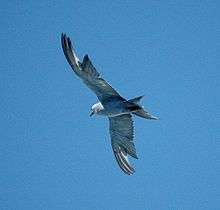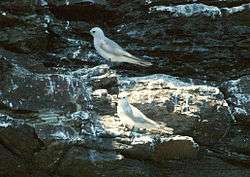Grey noddy
| Grey noddy | |
|---|---|
 | |
| Scientific classification | |
| Kingdom: | Animalia |
| Phylum: | Chordata |
| Class: | Aves |
| Order: | Charadriiformes |
| Family: | Sternidae |
| Genus: | Procelsterna |
| Species: | P. albivitta |
| Binomial name | |
| Procelsterna albivitta Bonaparte, 1856 | |

The grey noddy or grey ternlet (Procelsterna albivitta) is a seabird belonging to the tern family, Sternidae.[2] It was once regarded as a pale morph of the blue noddy (Procelsterna cerulea) but is now often considered to be a separate species.
Description
It is 25–30 cm (9.8–11.8 in) long with a wingspan of 46–61 cm (18–24 in) and a weight of about 75 grams (2.6 oz). The tail is fairly long and notched. The plumage is pale grey, almost white on the head and underparts but darker on the back, tail and wings. The wings have dark tips and a white hind edge and are mainly white underneath. The eye is black and appears large due to the black patch in front of it. There is a white patch behind the eye. The thin, pointed bill is black and the legs and feet are also black apart from pale yellow webs.
Juvenile birds are browner than the adults and have darker, more contrasting flight feathers.
The grey noddy is usually silent but has a soft, purring call.
Distribution
It occurs in subtropical and warm temperate waters of the south Pacific Ocean. The subspecies P. a. albivitta breeds on Lord Howe Island, Norfolk Island, northern New Zealand (particularly the Kermadec Islands) and southern Tonga (on 'Ata and probably 'Eua). P. a. skottsbergii is found on Henderson Island, Easter Island and Sala y Gómez. P. a. imitatrix breeds on the Desventuradas Islands off the coast of Chile. Some specimens have also been found in Australia,[3] Pitcairn Islands,[4] San Abrosio and San Feliz Islands[5] and Ellice Islands.[6]
Behaviour
It feeds in shallow water, not moving far from the breeding colonies. It gathers in large feeding flocks which can contain thousands of individuals. They feed by hovering over the water and dropping down to pick food from the surface. Plankton forms the bulk of the diet and small fish are also eaten.
Breeding takes place in colonies on rocky islands. The nest site is a sheltered rocky surface or underneath a boulder or clump of vegetation. A single egg is laid. It is whitish with dark markings and is incubated by both parents for about 32 days. The young birds are fed on regurgitated food and fledge after around 35 days.
References
| Wikimedia Commons has media related to Procelsterna albivitta. |
| Wikispecies has information related to: Procelsterna albivitta |
- ↑ Birdlife International (2014). "Procelsterna albivitta". IUCN Red List of Threatened Species. Version 2014.3. International Union for Conservation of Nature. Retrieved 10 January 2015.
- ↑ Bridge, Eli S.; Jones, Andrew W.; Baker, Allan J. (2005). "A phylogenetic framework for the terns (Sternini) inferred from mtDNA sequences: implications for taxonomy and plumage evolution". Molecular Phylogenetics and Evolution. 35 (2): 459–469. doi:10.1016/j.ympev.2004.12.010. ISSN 1055-7903. PMID 15804415.
- ↑ Mayr, E.; Serventy, D.L. (1944). "The Number of Australian Bird Species.". Emu. 44 (1): 33. doi:10.1071/MU944033. ISSN 0158-4197.
- ↑ Williams, G. R. (2008). "THE BIRDS OF THE PITCAIRN ISLANDS, CENTRAL SOUTH PACIFIC OCEAN". Ibis. 102 (1): 58–70. doi:10.1111/j.1474-919X.1960.tb05092.x. ISSN 0019-1019.
- ↑ Millie, W. R. (2008). "BRIEF NOTES ON THE BIRDS OF SAN AMBROSIO AND SAN FELIX ISLANDS, CHILE". Ibis. 105 (4): 563–566A. doi:10.1111/j.1474-919X.1963.tb01592.x. ISSN 0019-1019.
- ↑ Sharpe, E. Bowdlee (2009). "On a small Collection of Birds from the Ellice Islands.". Proceedings of the Zoological Society of London. 46 (1): 271–274. doi:10.1111/j.1469-7998.1878.tb07952.x. ISSN 0370-2774.
- Heather, Barrie D. & Robertson, Hugh (1996) The Field Guide to the Birds of New Zealand, Viking.
- Jaramillo, Alvaro; Burke, Peter & Beadle, David (2003) Field Guide to the Birds of Chile, Christopher Helm, London.
- Pizzey, Graham & Knight, Frank (1997) The Graham Pizzey & Frank Knight Field Guide to the Birds of Australia, HarperCollins, London.
- Watling, Dick (2001) A Guide to the Birds of Fiji & Western Polynesia, Environmental Consultants (Fiji), Suva.
